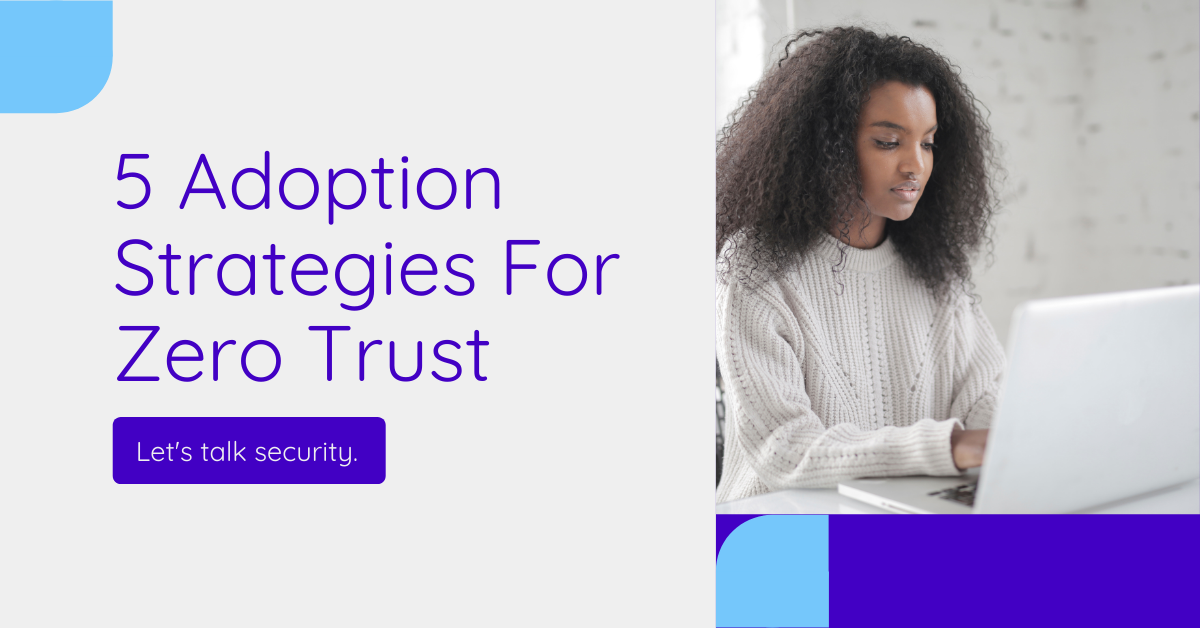This post will show you 5 adoption strategies for Zero Trust.
Zero Trust is an important part of every organization’s security strategy in today’s cyber climate. Let’s first see why Zero Trust has such an essential place in cybersecurity practices.
Zero Trust assumes that there has been a breach and validates each request as though it came from an uncontrolled network. This is why the slogan of Zero Trust is “never trust, always verify.” That implies you should never trust anybody or anything, whether inside or outside the firewall, on the endpoint, server, or in the cloud.
Although each company’s path to Zero Trust is unique, Zero Trust adoption can be divided into five stages.
Table of Contents
5 Adoption Strategies For Zero Trust
Strategy #1 – Don’t give anonymous access to anything
As the first strategy, companies should begin constructing the context from the initial point of contact. Define identity and access management including roles and role membership, private application discovery, and a list of allowed SaaS apps and website categories.
It’s important to reduce lateral movement chances and protect apps from being fingerprinted, port scanned or probed for vulnerabilities. Organizations should also require multi-factor authentication (MFA) and single sign-on (SSO).
Access control is no longer merely about delivering a code to your phone or email. Attackers, like the rest of the digital world, are developing, and we must develop too. While traditional password-based authentication is still in use, security methods must be enhanced to mitigate the inherent risk, and we must stay diligent in our approach even then.
Strategy #2 – Embrace adaptive control
Controls based on Zero Trust must adapt to the risk environment. Even though a user has supplied the correct credentials, a stricter verification should be required before access is granted if the request comes in from a potentially dangerous place.
According to Toolbox, requiring the same process for point-in-time authentication to access resources is no longer acceptable, regardless of the subject’s risk profile. This is why adaptive control is so important.
Adaptive authentication assesses a subject’s risk profile based on a variety of factors. Each person’s risk profile varies depending on their role, location, resources they want to access, and behavior.
Adaptive control involves actively responding to incidents by shutting off sessions, adding more monitoring, or flagging for forensic follow-up, in addition to informing of harmful behavior in real-time.
Strategy #3 – Understand why on-demand isolation is important
During high-risk situations, on-demand isolation immediately kicks in. It pre-authenticates, pre-authorizes, and encrypts every connection between endpoints to decrease the attack surface further. However, it does not affect an endpoint’s usual activities until it is activated.
For SaaS applications that act badly when URLs are rewritten, this strategy requires enterprises to automatically insert remote browser isolation for access to dangerous websites or from unmanaged devices. Organizations should additionally monitor real-time threat and user dashboards for command-and-control efforts and anomaly detection.
Strategy #4 – Monitor sensitive data
One of the key objectives of security and compliance teams is to protect data. Companies must regularly monitor sensitive data to discover policy breaches and unsafe user activity. They can then take necessary action, such as cancelling access, barring users, and fine-tuning protection measures.
The most crucial capabilities for establishing Zero Trust are monitoring and logging. Companies can identify the difference between a regular login and a hacked user account if monitoring and data security analytics are in place. If a ransomware assault is underway or a hostile insider attempts to transfer files to their cloud storage, they’ll be alerted.
Strategy #5 – Take advantage of security automation and orchestration
Many cybersecurity teams still rely on manual methods to intervene when security concerns arise. However, manual security activities slow down the reaction time to cyberattacks. As a result, attackers have more time to steal data and cause harm. Automated security activities are an important part of a Zero Trust network implementation.
Orchestration is automation taken to the next level. It integrates the Zero Trust ecosystem and streamlines operations. This decreases risk while also making Zero Trust more manageable. It would be difficult to do this manually.
Security automation and orchestration automatically neutralize real threats as they arise. This also increases your IT security team’s efficiency by allowing them to concentrate on strategic projects rather than ineffective manual reaction intervention.
READ ALSO: Zero Trust Architecture: Enhancing Network Security
Demystifying Zero Trust: A User’s Guide
What is Zero Trust security strategy?
Zero Trust assumes constant breach and verifies every access attempt. It eliminates implicit trust and grants access only after rigorous authentication, authorization, and continuous monitoring.
What are the 5 pillars of Zero Trust?
- Identity: Strong authentication (MFA) verifies user identities.
- Devices: Device security measures ensure only authorized devices access the network.
- Network: Network segmentation limits access based on user and device.
- Applications and Workloads: Applications and workloads are secured with access controls.
- Data: Data security practices like encryption safeguard sensitive information.
What are the top three factors driving Zero Trust adoption?
- Increased cyberattacks: Zero Trust helps mitigate breaches by limiting access.
- Cloud adoption: Zero Trust secures access to cloud-based resources.
- Remote workforces: Zero Trust verifies access regardless of location.
How do you create a Zero Trust strategy?
- Assess Current Security: Evaluate your existing security posture and identify gaps.
- Define Goals and Requirements: Determine your Zero Trust objectives and resource needs.
- Develop a Phased Approach: Implement Zero Trust in stages, prioritizing critical areas.
- Invest in Training and Education: Educate employees on Zero Trust principles and protocols.
How do you build a successful Zero Trust strategy?
Building a successful strategy requires a holistic approach. Consider these factors:
- People: Invest in employee training and awareness programs.
- Processes: Develop clear policies and procedures for access control.
- Technology: Utilize security tools that support Zero Trust principles.
- Continuous Monitoring: Monitor activity for suspicious behavior.
Remember, Zero Trust is an ongoing journey, not a destination. Regularly review and adapt your strategy to stay ahead of evolving threats.
Conclusion – Save the headache while implementing Zero Trust
Developing a holistic approach to handle Zero Trust is crucial for an organization’s security. Typically, this layered strategy focuses on specific areas based on your company’s environment.
This may be a complicated procedure to manage. You can use a cybersecurity vendor’s skills and experience to save your company time and money while lowering risks.
INTERESTING POSTS
- Most Effective Cybersecurity Strategy For A Small Business [We Asked 45+ Experts]
- Cybersecurity Strategies To Protect Your Critical SaaS Data
- What Is Zero Trust Architecture All About?
- What Is Zero Day Exploit? Risks And Why Is It Called Zero Day?
- The Gaming Industry Must Be Proactive About DDoS Attacks
- 6 Smart Ways Web Developers Can Impact Climate Actions
About the Author:
Daniel Segun is the Founder and CEO of SecureBlitz Cybersecurity Media, with a background in Computer Science and Digital Marketing. When not writing, he's probably busy designing graphics or developing websites.








